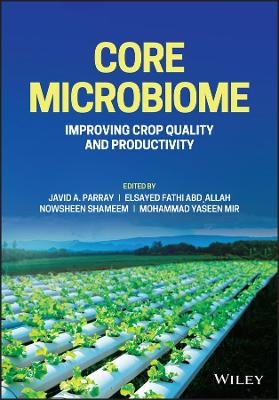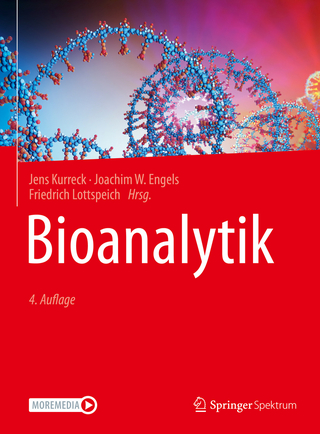
Core Microbiome
John Wiley & Sons Inc (Verlag)
978-1-119-83076-4 (ISBN)
As microbial cells are present in overwhelming numbers in our soil, it is perhaps inevitable that microbes are found extensively in plant and animal tissue. The role of microbiomes on the regulation of physiological processes in animals has been extensively researched in recent years, but the overarching role of the plant microbiome has yet to be discovered.
Core Microbiome: Improving Crop Quality and Productivity is an attempt to remediate some of that deficit, as the first book to summarize feature of microbial communities that make up the plant microbiome. There is substantial evidence that these communities are crucial in disease control, enhanced nutrient acquisition, and stress tolerance—a feature more important than ever due to climate change. A further focus on improving how core microbiomes interact so that they are both phenotypically and genotypically very adaptive and sustainable will allow the reader to improve the quality and productivity of crops so that they may be considered sustainable agriculture.
Core Microbiome readers will also find:
Descriptions of the basic structure of core microbiomes and their functions across various habitats
New and cutting-edge trends and technological innovations highlighted that use core microbiomes to harness plant microbiome interaction
The structure, classification, and biotechnological applications of aquatic core microbiomes, in addition to the material on plant microbiomes
As a broad introduction to the interaction of core microbiome and plant productivity, Core Microbiome is ideal for researchers and scientists working in the field of environmental science, environmental microbiology, and waste management. Similarly, undergraduate and graduate students in these fields, as well as in agriculture, biotechnology, biosciences, and life and environmental sciences will also benefit from this work.
Javid A. Parray is an Assistant Professor in the Department of Higher Education at Government Degree College, Eidgah Srinagar, India. Nowsheen Shameem is an Assistant Professor in the Department of Environmental Science, Cluster University Srinagar, Jammu and Kashmir, India. Elsayed Fathi Abd-Allah is an Assistant Professor in the Plant Production Department, College of Food and Agricultural Sciences, King Saud University, Riyadh, Saudi Arabia. Mohammad Yaseen Mir is a Research Scholar at the Centre of Research for Development, Hazrathbal Srinagar University of Kashmir, Jammu and Kashmir, India.
List of Contributors vii
Preface xi
1 A Review of Endophytic Microbiota of Medicinal Plants and Their Antimicrobial Properties 1
Robeena Sarah, Nida Idrees, and Baby Tabassum
2 Plant Microbiome: A Key to Managing Plant Diseases 10
Dipal B. Minipara, Khushboo Pachhigar, and Himanshu R. Barot
3 Impact of Microbiomes to Counter Abiotic Stresses in Medicinal Plants- A Review 30
Abeer Hashem, Khaloud Mohammed Alarjani, Khalid F. Almutariri, Javid A. Parray, Sushil K. Sharma, Ashwani Kumar, Turki M. Dawoud, Khalid S. Almaary, Nosheen Shameem, and Elsayed Fathi Abd-Allah
4 Uses of Compost in Agriculture and Bioremediation – A Review 51
Aparna Gunjal
5 Metagenomics and Microbiome Engineering: Identification of Core Microbiome and Improvement of Rhizosphere 58
Bahman Fazeli-Nasab, Nafiseh Mahdinezhad, and Javid A. Parray Copyrighted Material
6 Core Microbiome: Plant Growth and Development 101
Thirunarayanan P, Uday Kumar Thera, Tulasi Korra, and Manoj Kumar v
7 Microbiome Engineering and Biotechnology: The Real Finenesses of a Robust Rhizosphere 118
Barkha Sharma, Shalini Tiwari, and Kailash Chand Kumawat
8 Role of Rhizospheric Microbiome in Enhancing Plant Attributes and Soil Health for Sustainable Agriculture 139
Sandeep Sharma and Kailash Chand Kumawat
9 Toxic Effects of Some Herbicides on the Fatty Acid Profile of Wheat Varieties: A Phytomicrobiome Study 163
Fadime Karabulut and Songul Çanakcı-Gulengul
10 Microbial Prospects in Sediment Denitrification of Eutrophic Wetland Ecosystems 183
Rupak Kumar Sarma and Kamal Choudhury
11 Role of Plant Microbiome in Carbon Sequestration for Sustainable Agriculture 190
Ranjith Sellappan, Aswini Krishnan, and Kalaiselvi Thangavel
12 Functions and Emerging Trends of the Microbial Community in Heavy Metals Bioremediation: A Review 206
Nida Idrees, Robeena Sarah, and Baby Tabassum
13 Microbiomics and Sustainable Agriculture: New Frontiers 212
Shabeer Ahmad Dar, Mohammad Yaseen Mir, Azra N. Kamili, Irshad Ahmad Nawchoo, and Shabir Ahmad Bhat
14 Role of Nanotechnology in Soil Microbiome and Agricultural Development 230
Bisma Farooq, Shahnaz Anjum, Madiha Farooq, Gulzar Ahmed Rather, Asma Nazir, Bijaya Kumar Nayak, and Anima Nanda
15 Microbial Biofilms: Optimal Genetic Material Exchange in a Microbiome Environment 249
Niraj Singh and Pranjal Pratim Das
16 Rhizosphere Improvement: Role of Biotechnology and Microbioengineering 268
Afrozah Hassan and Irshad Ahmad Nawchoo
17 Exploring Biological Agents and Core Microbiomes as a Tool for Reclamation of Abandoned Mines 288
Seema B. Sharma and Rupak Dey
18 Mycorrhizal Strategy for the Management of Hazardous Chromium Contaminants 298
Abeer Hashem, Nowsheen Shameem, Javid A. Parray, and Elsayed Fathi Abd-Allah
Index 315
| Erscheinungsdatum | 06.06.2022 |
|---|---|
| Verlagsort | New York |
| Sprache | englisch |
| Maße | 170 x 244 mm |
| Gewicht | 794 g |
| Themenwelt | Naturwissenschaften ► Biologie ► Mikrobiologie / Immunologie |
| Weitere Fachgebiete ► Land- / Forstwirtschaft / Fischerei | |
| ISBN-10 | 1-119-83076-1 / 1119830761 |
| ISBN-13 | 978-1-119-83076-4 / 9781119830764 |
| Zustand | Neuware |
| Haben Sie eine Frage zum Produkt? |
aus dem Bereich


